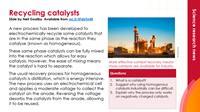A novel catalyst recovery process enables precious metals to be reused in catalysis again and again
-

Download this
Use this story and the accompanying summary slide to add new context when teaching ways to reclaim catalysts to your 14–16 learners.
Download the story as MS Word or PDF and the summary slide as MS PowerPoint or PDF
A new, more efficient process to recycle some homogeneous catalysts has been demonstrated by scientists in the US. Their electrochemistry technique, which reversibly binds the catalysts to a polymer surface, can recover several industrially important catalysts.
Separation troubles
Catalysts speed up chemical reactions without being consumed. They can be heterogeneous, where the catalyst is in a different phase from the reactants, or homogeneous, where the catalyst is in the same phase as the reactants. While homogeneous catalysts offer several performance advantages over heterogeneous catalysts, it can be taxing to recover them from reaction mixtures once reactions are complete.

Homogeneous catalysts are often precious metal complexes; their high prices mean that they need to be able to be reused many times for the reactions to be economically viable. Catalyst recovery challenges help explain why 75% of catalysts used in chemical and petrochemical industries are heterogeneous rather than homogeneous.
Distillation is one of the few existing methods for recovering homogeneous catalysts. However, it is energy intensive and requires high temperatures which breakdown the catalyst structure. Gentler electrochemical alternatives, which can recover the catalyst completely and have smaller carbon footprints, are highly sought after.
Electrochemical solutions
Xiao Su and colleagues at the University of Illinois at Urbana–Champaign have recently developed a novel electrochemical method that can be used to recover complete precious metal catalysts from a variety of industrial reactions. These reactions include silane etherification, hydrosilylation and Suzuki cross-coupling.
A key component of the team’s recycling method is a specially designed polymer surface for the anode. When a moderate voltage is applied across the reaction mixture, the catalyst separates from the reaction mixture and absorbs onto the anode’s surface. This process is gentle enough not to tear the ligands off the precious metal. To reuse the catalyst, the potential is reversed, releasing the catalyst from the anode into a new solution.
The team demonstrated that homogeneous catalysts could be reused for many cycles using their recycling method. Xiao is now hoping to develop different polymer surfaces that can selectively bind other industrially useful homogeneous catalysts from reaction mixtures. ‘The silver bullet would be to enable homogeneous catalysts to be used that are not used in industry today,’ says Xiao.
Put this in context
Find out about the role of research fellow, Zubera, who is discovering the best ways to recycle electric car batteries.
This article is is adapted from Tim Wogan’s in Chemistry World.
Nina Notman
Reference
S Cotty et al, Sci. Adv., 2022, 8, (DOI: 10.1126/sciadv.ade3094)
Downloads
EiC science research story Recycling catalysts
Handout | PDF, Size 0.21 mbEiC summary slide Recycling catalysts
Presentation | PDF, Size 0.25 mbEiC science research story Recycling catalysts
Handout | Word, Size 0.57 mbEiC summary slide Recycling catalysts
Presentation | PowerPoint, Size 8.66 mb














1 Reader's comment